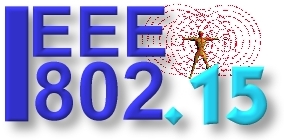
How to become an IEEE 802.15.4 expert.
|
|
- How to get an introduction to the IEEE 802.15.4b-2003 standard
- How to get an overview of the 802.15.4a Task Group
- How to get an overview of the 802.15.4b Task Group
- How to join the appropriate IEEE mailing reflectors
- How to download the official IEEE 802.15.4-2003 standard
- How to access 802.15 documents
- How to interpret those astonishingly long IEEE document names
- How to format and submit an 802.15.4 document
How to get an introduction to the IEEE 802.15.4-2003 standard
The IEEE 802.15.4-2003 standard was approved in May of 2003 and was published in October of the same year. With the release of the standard the work of the task group 4 was completed and the group was put into hibernation (this is the IEEE 802 way of saying there is no work going on in the task group and the group does not meet on a regular basis). However, the work in the area of low-rate wireless personal area network area did not stop here. There are currently 2 new task groups, 802.15.4a and 802.15.4b, continuing the development.
If you like a brief introduction to IEEE 802.15.4-2003 without having to read the entire standard the following 2 documents may help:
Alternatively, you may want to purchase the book titled "Low-Rate Wireless Personal Area Networks: Enabling Wireless Sensors with IEEE 802.15.4 ™" by José A. Gutierrez, Ed Callaway and Raymond Barrett.
How to get an overview of the 802.15.4a Task Group
The IEEE 802.15.4a task group is charged with developing an amendment to the current IEEE 802.15.4-2003 for an alternate PHY. The primary interest in developing this alternate PHY is to provide communications and high precision ranging / location capability, high aggregate throughput, and ultra low power. The group is also looking at adding scalability to data rates, longer range, and lower power consumption and cost. Here is a link to the official IEEE 802.15.4a Task Group web page.How to get an overview of the 802.15.4b Task Group
The IEEE 802.15.4b task group is charged with refining the current IEEE 802.15.4-2003 specification to clear up ambiguities, resolve inconsistencies, and make specific extensions: a faster sub-GHz physical interface, and extensions to support time synchronization. Here is a link to the official IEEE 802.15.4b Task Group web page.How to join the IEEE 802.15 mail reflectors
E-mail sent to mailing lists is the primary means for members of an IEEE Working Group or Task Group to communicate with each other. To join the 802.15.4b mailing list visit http://listserv.ieee.org/cgi-bin/wa?SUBED1=STDS-802-15-4b and follow the directions there. To join the 802.15.4a mailing list visit http://listserv.ieee.org/cgi-bin/wa?SUBED1=STDS-802-15-4a and follow the directions there. http://grouper.ieee.org/groups/802/15/pub/Subscribe.html is the official web page for joining, leaving, and mailing to other IEEE 802.15 mailing lists.How to download the official IEEE 802.15.4-2003 standard
If you look hard enough, you'll find that the official IEEE 802.15.4-2003 standard is available for free download at the site http://standards.ieee.org/getieee802/download/802.15.4-2003.pdf. (If you look less hard, you'll find the IEEE site that offers to sell it to you for lots of money, but you can get it as a hardcopy)How to ACCESS 802.15 documentS
Information on accessing 802.15 documents is available at http://grouper.ieee.org/groups/802/15/pub/Download.html. How to interpret those astonishingly long IEEE document namesA typical filename for an 802.15 document is:
15-04-0422-08-004b-00-004b-timing-primitives-802.15.4b.ppt
<15> means it's a 802.15 document.<04> means that revision 0 was submitted in 2004
<0422> is the "document control number"
<00> is the revision number. This is revision 0.
<004b> means this is part of TG4b.
<timing-primitives-802.15.4b> is the title of the document.
<.ppt> is the extension Note that if rev 0 of a document was submitted in 2003, and rev 8 was created in 2004, the document is still listed in the 03 directory, with a 15-03- prefix.
How to format and submit an 802.15.4 document
If you are called upon or otherwise inspired to submit an official 802.15.4 document, you must first get an account on 802wirelessworld. When you log onto the 802wirelessworld page and click on the 802.15 WPAN WG link in the left hand column, you'll see more options than you did before. In particular, you'll see a Documents link that will put a listing of current documents into the main frame. At the top of the frame, you'll see a "Document Control Numbers" tab. Click on that, select sub-Group (such as 802.15 TG4b), a document title, author and company, and click on the "request DCN" tag. The system will respond with a document control number and other information. All submissions must use the official templates and be posted on the document server before presenting it at an official meeting. The templates can found in Documents/Document Templates/ directory on the document server (described above). Fill in the document, give it the full name as described above under How to interpret those astonishingly long IEEE document names with your DCN filled in, and click on the Choose File button at the bottom of the Document Control Numbers page. If you've filled in everything correctly, the document server will upload your document with the assigned document control number. -- Robert Poor [ robert.poor at ember.com ]The Institute of Electrical and Electronics Engineers, Inc.